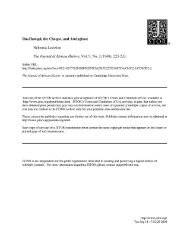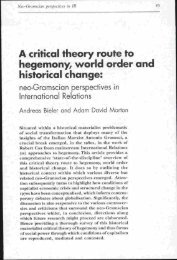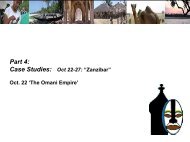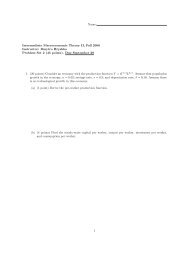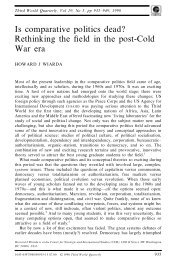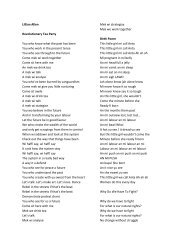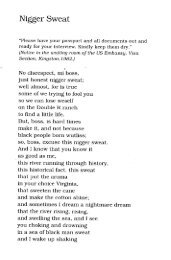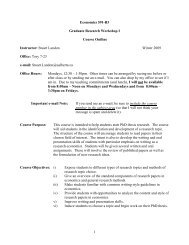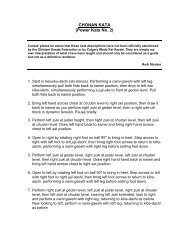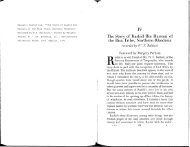personal memories revolutionary states and indian ocean migrations
personal memories revolutionary states and indian ocean migrations
personal memories revolutionary states and indian ocean migrations
You also want an ePaper? Increase the reach of your titles
YUMPU automatically turns print PDFs into web optimized ePapers that Google loves.
1 Al-Rayyis was moved by the Swahili tarab, which, for the ears of an Arab like him, was nothing but<br />
an Arab tarab. This music <strong>and</strong> the Zanzibari ‘Umm Kulthūm’ performing <strong>and</strong> singing in both Arabic<br />
<strong>and</strong> Swahili woke in him, as he said, “my historical senses <strong>and</strong> moved in me nostalgic sentiments. I<br />
almost forgot that I was half the globe away from Beirut…” Upon leaving this performance, he felt<br />
inside him “a strong bitterness for an Arab Andalusia that Arabs lost in Africa.” Riyād Najīb al-Rayyis,<br />
Ṣahāfī wa madīnatayn: rihla ilā Samarq<strong>and</strong> wa Zanjabār (Beirut: Riyād al-Rayyis Books, 1997), 192-193.<br />
2 As M<strong>and</strong>ana Limbert argues in this volume, not all Omanis enjoyed an ‘elite’ social <strong>and</strong> economic<br />
stature. “Many were considered of lower status than the Omanis who had settled in Zanzibar in the<br />
previous centuries <strong>and</strong> who had established themselves as an elite, creole community <strong>and</strong> were known<br />
as Mangan Arabs.” Idem, “Personal Memories, Revolutionary States <strong>and</strong> Indian Ocean Migrations.”<br />
According to one British official document, Manga Arabs were defined as being “of a wild,<br />
ungoverned nature, turbulent <strong>and</strong> prepared at all times for any mischief…”, a description different<br />
from that given to the ‘elite’, as shown in this work. PRO CO 618/66/1, 07 February, 1936, 3. (Report<br />
of the Commission of Enquiry Concerning the Riot in Zanzibar on the 7 th of February, 1936).<br />
3 R<strong>and</strong>all L. Pouwels, Horn <strong>and</strong> Crescent: Cultural Change <strong>and</strong> Traditional Islam on the East African Coast,<br />
800-1900 (Cambridge: Cambridge University Press, 1987), 191.<br />
4 See, for example, Laura Fair, Pastimes <strong>and</strong> Politics: Culture, Community, <strong>and</strong> Identity in Post-Abolition Urban<br />
Zanzibar, 1890-1945 (Athens: Ohio University Press, 2001), 42.<br />
5 See Francis Robinson, “The British Empire <strong>and</strong> the Muslim World,” The Oxford History of the British<br />
Empire, eds., Judith et al., vol. 4, (Oxford: Oxford University Press, 1998), 406.<br />
6 Fair, Pastimes <strong>and</strong> Politics, 38.<br />
7 Norman R. Bennett, A History of the Arab State of Zanzibar (London: Methuen & Co., 1978), 222-231.<br />
8 This, however, does not mean that each <strong>and</strong> every member of the Omani elite articulated opposition<br />
to the British <strong>and</strong> their policies. Omani intellectuals were as critical of the British as they were of other<br />
Omanis who either did not dare to criticize the British or did not hesitate to implement their policies.<br />
In any case, members of the Omani elite who voiced their opposition <strong>and</strong> adopted an anti-colonial<br />
discourse seem to have dominated Omani intellectual life on the isl<strong>and</strong> <strong>and</strong> to have shaped the<br />
political opposition to colonialism.<br />
9 Engseng Ho uses the term ‘parochialization’ to refer to “the imprint of colonial history, <strong>and</strong> of<br />
colonial categories which still organize its historiography” in his study on Arabs in the British <strong>and</strong><br />
Dutch colonies in Southeast Asia. This, as he observed, occurred at a number of levels, from defining<br />
a political geography that later became a ‘national’ geography, to dividing time into specific historical<br />
periods to, most significantly, creating racial categories out of multi-ethnic conglomerates. Idem,<br />
“Before Parochialization: Diasporic Arabs Cast in Creole Waters,” Huub de Jonge <strong>and</strong> Nico Kaptein,<br />
eds. Transcending Borders: Arabs, Politics, Trade <strong>and</strong> Islam in Southeast Asia (Leiden: KITLV Press, 2002),<br />
11-35.<br />
10 As Adeed Dawisha indicates, the concept of an Arab world is “a cultural rather than a political<br />
construct, <strong>and</strong> consequently, there has been considerable shift over time in the conceptual delineation<br />
of the l<strong>and</strong> mass inhabited by ‘Arabs’.” Adeed Dawisha, Arab Nationalism in the Twentieth Century: From<br />
Triumph to Despair (Princeton: Princeton University Press, 2003), 14.<br />
11 The impact of those three elements on defining an Arab-Muslim identity is best captured by Albert<br />
Hourani in his prologue to his seminal work A History of the Arab Peoples, a prologue centered around<br />
the career of ‘Abd al-Raḥmān ibn Khaldūn. Idem, A History of the Arab Peoples (London: Faber &<br />
Faber, 1991), 4.<br />
12 While the Arabic language has always been the basis for defining an Arab identity, ideologues of<br />
Arab nationalism (<strong>and</strong> therefore Arab identity) were split on the role of Islam in defining that identity.<br />
The secular version of Arab nationalism, as formulated by someone like Ṣāṭi‘ al-Ḥuṣrī for example, did<br />
not accommodate Islam but rather considered it problematic in defining the national identity of Arabs.<br />
See William L. Clevel<strong>and</strong>, The Making of an Arab Nationalist: Ottomanism <strong>and</strong> Arabism in the Life <strong>and</strong><br />
Thought of Sati‘ al-Husri (Princeton: Princeton University Press, 1971). However, Arab identity as<br />
defined by Arab Islamists considered Islam as its backbone. This was expressed by Muslim reformers<br />
such as Muḥammad ‘Abduh, ‘Abd al-Raḥmān al-Kawākibī, Rashīd Riḍā, Shakīb Arslān, Muḥibb al-Dīn<br />
al-Khaṭīb <strong>and</strong> many others. The Arab-Muslim identity <strong>and</strong> the version of Arab nationalism examined<br />
here is the one that reckoned on both language <strong>and</strong> religion as propagated not by secular ideologues<br />
such as al-Ḥuṣrī but by those religious reformers mentioned above. See, for instance, William L.<br />
Clevel<strong>and</strong>, Islam against the West: Shakib Arslan <strong>and</strong> the Campaign for Islamic Nationalism (Austin: University<br />
of Texas Press, 1985), Ernest C. Dawn, “The Origins of Arab Nationalism,” in The Origins of Arab<br />
Nationalism, eds., Rashid Khalidi et al. (New York: Columbia University Press, 1991), 3-30, Israel<br />
Gershoni <strong>and</strong> James Jankowski, Redefining the Egyptian Nation, 1930-1945 (Cambridge: Cambridge<br />
Vol. 5, Fall 2005, © 2005 The MIT Electronic Journal of Middle East Studies<br />
54



